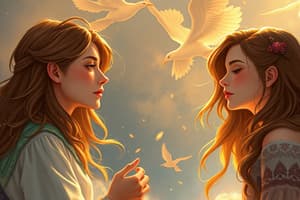Podcast
Questions and Answers
Which of the following best describes the structure of the poem as a whole?
Which of the following best describes the structure of the poem as a whole?
- Four contrasting views of an emotion, with no final resolution
- Three increasingly ominous representations of a process, followed by an optimistic assertion (correct)
- Three different conceits about the power of an idea, followed by generalization about its ultimate fragility
- An extended comparison, in which two concepts are eventually shown to be at odds
- A dispassionate analysis of an event, devoid of personal reference until the final image
The first twelve lines of the poem primarily focus on the
The first twelve lines of the poem primarily focus on the
- Relentlessness of time (correct)
- Saving power of poetry
- Courage to resist fate
- Fragility of beauty
- Painfulness of death
The action of the waves in lines 1-4 is best described as
The action of the waves in lines 1-4 is best described as
- A reassuring monotony
- A confused jumble
- An inexorable procession (correct)
- A mysterious transformation
- A remorseless competition
The subject of lines 1-4 is best described as the
The subject of lines 1-4 is best described as the
In line 5, 'Nativity' refers primarily to the
In line 5, 'Nativity' refers primarily to the
In line 6, the word 'Crawls' serves primarily to
In line 6, the word 'Crawls' serves primarily to
The image of 'Crooked eclipses' is most closely linked to which other image in the poem?
The image of 'Crooked eclipses' is most closely linked to which other image in the poem?
In context, the phrase 'transfix the flourish' (line 9) is best understood to mean
In context, the phrase 'transfix the flourish' (line 9) is best understood to mean
The verbs in lines 9-13 'transfix', 'delves', 'feeds on', and 'now' serve to dramatize
The verbs in lines 9-13 'transfix', 'delves', 'feeds on', and 'now' serve to dramatize
Line 12, 'And nothing stands but for his scythe to mow' is best paraphrased as
Line 12, 'And nothing stands but for his scythe to mow' is best paraphrased as
The end rhymes of the poem divide it formally into
The end rhymes of the poem divide it formally into
Flashcards are hidden until you start studying
Study Notes
Structure and Themes
- The poem features an overall structure that presents three increasingly ominous representations of a process, concluding with an optimistic assertion.
- The primary focus of the first twelve lines revolves around the relentlessness of time.
Imagery and Symbolism
- The action of the waves in lines 1-4 is characterized as an inexorable procession, emphasizing the unstoppable nature of time.
- The subject of these lines depicts the elapsing minutes of our lives.
- The phrase "Nativity" in line 5 refers to the earliest stage of life, highlighting themes of birth and beginnings.
Word Choices and Meanings
- The word "Crawls" in line 6 evokes both a baby's movements and the notion that time seems slow during youth, indicating a gradual passage of life.
- The image of "Crooked eclipses" is closely linked to "the main of light" in line 5, suggesting contrasts between darkness and illumination in life.
Poetic Devices and Effects
- The phrase "transfix the flourish" (line 9) means to finish the vitality, reflecting on the permanence versus impermanence of existence.
- Verbs such as "transfix," "delves," "feeds on," and "now" in lines 9-13 dramatize time's absolute control over human life, emphasizing its relentless nature.
Themes of Mortality and Permanence
- Line 12, "And nothing stands but for his scythe to mow," can be paraphrased as everything exists only to be destroyed, underscoring the inevitability of mortality.
- The poem formally divides into three quatrains and a couplet, following a traditional poetic structure that contributes to its rhythm.
Key Insights on Art and Experience
- The speaker expresses despair regarding the endurance of art amidst the inevitabilities of time, reflecting on the fragile relationship between creativity and mortality.
Studying That Suits You
Use AI to generate personalized quizzes and flashcards to suit your learning preferences.




